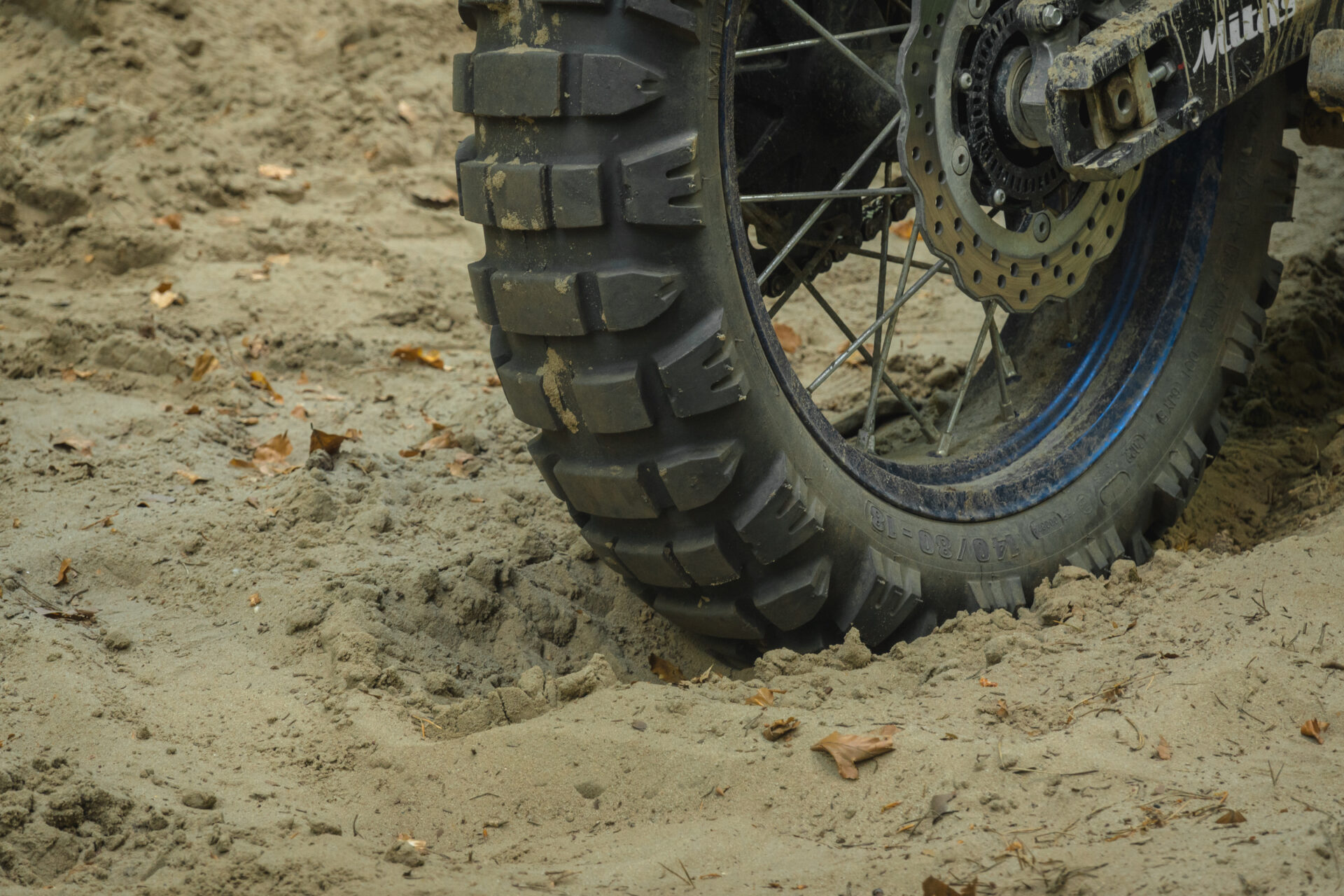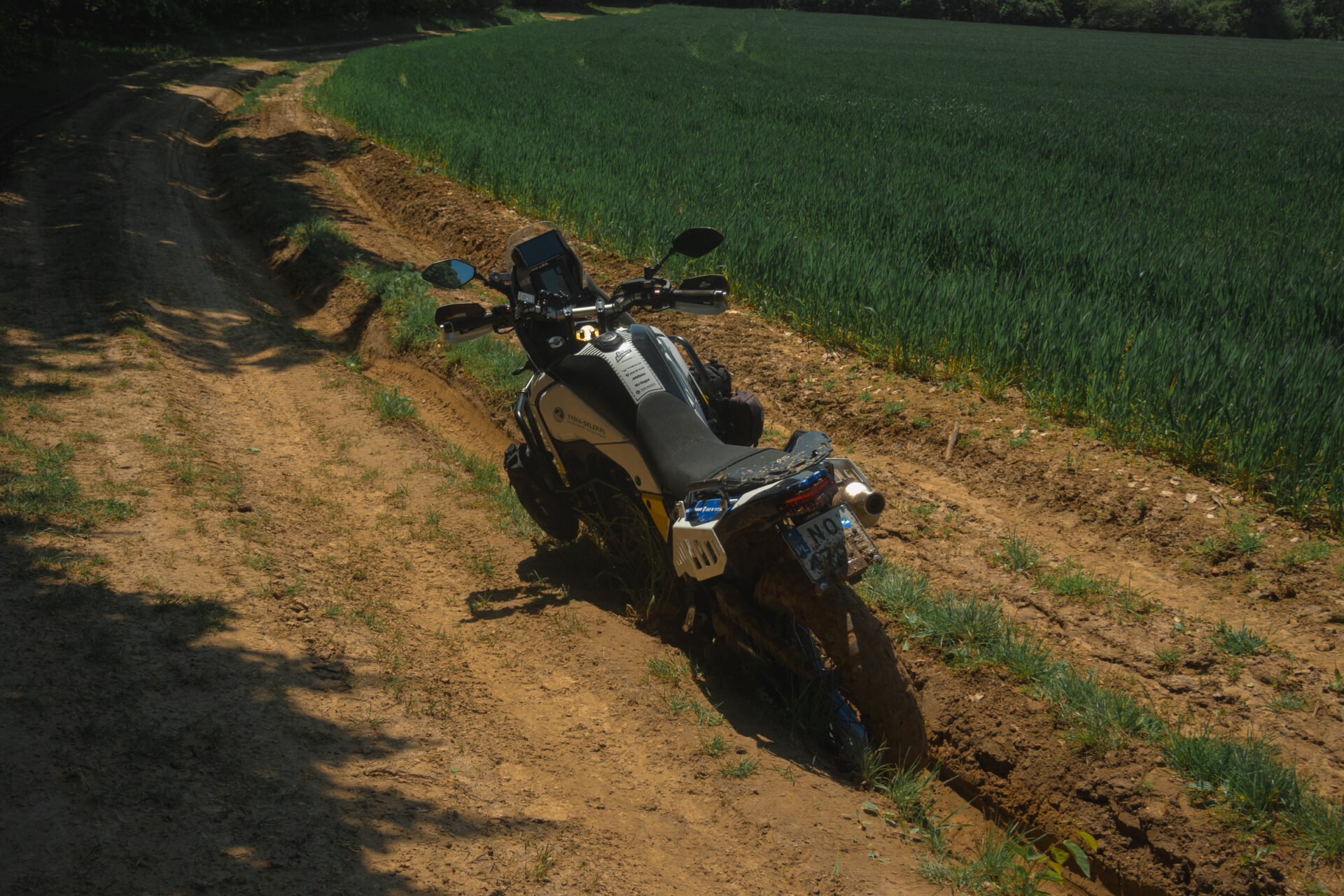I pondered for a long time the sense of buying a steering damper for the Tenere 700. Not because I had doubts about whether it works — I know it does. After all, it’s a basic accessory for rally riders. But precisely because I don’t rally ride I wondered whether, with the touring riding I do, this golden marvel would live up to its potential. Today, I already know the answer.
If you want to discover the true potential of your off-road companion and provide yourself stability, control, and confidence like never before, then Scotts is your choice.

Installation
The process of installing the Scotts steering stabilizer for Tenere 700 is so simple that even I was able to manage the task by spending just one day in the garage. The detailed instructions included in the kit guide you step by step. A few basic tools are needed to put on the steering stabilizer. I show the entire mounting process and instructions in my YouTube video:
Scotts Steering Stabilizer Configuration
Scotts steering stabilizer offers users three adjustment knobs to customize its operation to suit individual preferences and riding conditions.

- Base valve: The base valve is responsible for controlling the damping force of the handlebar. It allows you to adjust the strength to which the shock absorber dampens steering movements while riding.
By turning the knob in the direction of increasing damping, you can increase the resistance and stiffness of the steering wheel, which is useful in more demanding off-road conditions such as riding over rough or rocky terrain. Conversely, by turning the knob in the direction of decreasing damping, you can achieve freer and smoother rolling of the handlebars, which can be beneficial on flat and level terrain.
A key feature is that you can adjust the base valve while riding.
A full turn is divided into 8 clicks.
A maximum of 3 full turns can be made. - High speed valve: The high speed valve is responsible for controlling the rebound of the steering wheel after a sudden turn or maneuver. It allows you to adjust the intensity of the handlebars’ rebound.
This knob is designed to help absorb large, unexpected impacts, such as hidden tree roots or holes. It reacts to spikes that exceed the base valve setting.
Personally, I think that for most users – including me – there is no need to change what the default setting is. More advanced riders can check the manual: Scotts Steering Stabilizer Manual - Sweep control valve: The sweep control valve allows you to adjust the range of the distance of damping force. It allows you to control the area in which it actively operates and affects the handlebars.
By turning the knob in the direction of increasing the range, the damper will operate over a larger range of handlebars movement. Conversely, by turning the knob in the direction of decreasing the range, you can narrow the area in which the damper actively acts, which can be beneficial to preserve the natural movement of the handlebars on more level terrain. I, for my riding style, left the default setting, which seems ideal.
With these three adjustment knobs, the motorcyclist can adjust the action of the Scotts steering stabilizer to suit their preferences and riding conditions. Thus, they ensure optimal control, stability, and comfort while riding.


Is It Worth Installing a Steering Stabilizer for Leisure Touring?
Early on in my off-road adventure, I noticed a significant improvement in stability accompanying a reduction in steering vibration.
Confidence in Difficult Terrain
What sets the Scotts Steering Damper apart is its ability to instill unwavering confidence in the face of difficulties in the wilderness. When traversing dangerous trails full of rocks and sand, the damper absorbs and minimizes shocks, allowing for complete control and focus. It has proven to be an indispensable ally against “tank slappers” that can surprise even the most experienced riders.

Riding in the Sand Is No Longer So Scary
Until recently, as soon as I saw sand I would stiffen with fear and look for a detour. I have already seen fractures resulting from riding on sand paths. The handlebars shock absorber for the Tenere 700 helped me to overcome my fear.
Riding on loose and unstable ground, such as sand, often causes the motorcycle to sway and the handlebars to vibrate unpredictably. The Scotts damper is designed to minimize these unwanted effects. Thanks to its well-tuned damping, the stabilizer effectively reduces sway and vibration, resulting in a more stable and smoother ride. This allows you to focus on maintaining balance and precisely maneuvering through the sand.

Scotts damper improves control and handling by minimizing unpredictable steering movements, known as shimmy vibration. By dampening, the stabilizer reduces the risk of sudden steering movements, as they are the culprit of my repeated falls.
Scotts stabilizer plays a key role in keeping the front wheel trajectory when riding on sand. Instead of squeezing the handlebars hard, you need to let the front wheel gently “float” on the surface of the sand, allowing it to adjust to the terrain. Scotts shock absorber will help reduce uncontrollable steering movements and provide additional stability during this “floating”. I would just add that when riding in the sand, it’s a good idea to focus on using the footrests instead of turning the handlebars.

Riding in Ruts
Ruts worn out by aggressively driving 4×4 travelers often make motorcycle travel difficult. With a steering damper, riding in ruts is easier because the handlebars don’t move like crazy.
No More Holding the Handlebars Too Tightly
Thanks to the steering stabilizer for my Tenere 700, I no longer have to hold the handlebars so tightly while riding. Previously, worries about sudden wheel bumps and uncontrollable bounces often made me squeeze the handlebars out of fear. However, the use of a stabilizer dampens these unwanted effects, providing greater stability and control.
With or without a damper, when holding the handlebars it’s important to keep your elbows wide and the handlebars fairly loose, but this is sometimes forgotten.


Quality Workmanship
Scotts has earned its reputation for delivering unparalleled quality, and the steering stabilizer is no exception. Built from the highest quality materials, the damper exudes solidity and durability. You can see and feel that it has been designed to withstand the toughest trials in the wilderness.
How about Cheaper Alternatives?
It’s often tempting to choose cheaper alternatives to reputable products. However, when it comes to motorcycle accessories, especially those that directly affect handling, the decision to buy cheaper counterfeits can involve serious risks and dangers, putting us at risk.
Cheap fakes often skimp on quality, using inferior materials and forgoing accurate manufacturing processes. As a result, the quality of the product decreases significantly, leading to less durability, susceptibility to failure, and lack of resistance to harsh off-road riding conditions.
Genuine patented accessories go through rigorous processes to ensure optimal performance and efficiency. Counterfeits are often mass-produced without proper quality control.
My motto is: I can’t afford cheap stuff. And I mean both money and time. Just consider whether it’s better to buy once more expensive and have peace of mind, or to buy every year something of not-so-good durability.
Much could be said about fakes, but that’s not what this post is about. Nevertheless, this is a good example to make it clear what, in my opinion, is worth buying and what is not.
Servicing
This is not a put-on-and-forget accessory. There’s oil inside the steering damper, which should be changed according to the manufacturer’s recommendations. Servicing the Scotts stabilizer is quite simple.
Inspection and maintenance are recommended every 10,000km or so, or once a year, depending on riding conditions.
Scotts provides detailed instructions for damper maintenance and service with the product. You can perform some maintenance yourself, such as lubricating the bearing, checking and adjusting the knobs, or cleaning the damper’s outer components.
It’s a good idea to consult the manufacturer or take a peek at the manual to get the right information on oil changes or gaskets.

Price
Golden yet modest. Despite the high price, I find that this accessory is worth any money. It took me a long time to convince myself to buy it but in the end, I thought:
“If I could pay 300 EUR every time a serious fall happens to me with a potential injury, I would rather spend the money and protect my health”.
Already during one season, I feel that Scotts has saved me from falling many times. Another thing is that I ride more courageously because of this golden beauty than before.
Summary
All in all, the Scotts Steering Damper is an indispensable upgrade for Yamaha Tenere 700 owners who want to realize the motorcycle’s full potential during their off-road travels. Seamless installation, unparalleled performance, off-road riding confidence, and unmatched build quality make it an investment worth considering.
Thanks to the Scotts stabilizer, my rides are more dynamic and my mind stays calm.


 Facebook
Facebook Instagram
Instagram Youtube
Youtube








